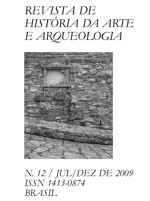Abstract
The human colonization of the Amazon was held by companies of pioneers huntergatherers adapted to different ecosystems and resources of the rainforest. These companies, over thousands of years of adjustment, had sufficient time to meet, manage and grow the plants operating. But to add to this argument the fact that traces of management associated with the agricultural population, whose plants used were the same people consumed by pioneers, it is likely that there would have been a continuity, especially with regard to resources explored, the feeding habits and, consequently, the construction of social landscapes, all regionally consummated in neotropical Amazonian forest.
References
ROOSEVELT, A., MACHADO, C. L., MICHAB, M., MERCIER, N., SILVEIRA, M. I., HANDERSON, A., SILVA, J., RESSE, D. S. Paleo-Indian Cave Dwellers in the Amazon: the Peopling of the Americas. Science. 1996, vol. 272 (19 April), pp. 373-384.
BAILEY, R.C. et al. Hunting and Gathering in Tropical Rain Forest: Is it Possible? American Anthropolog y, Washington, DC, 91(1):59-82, 1991.
BINFORD, Lewis R. Willow smoke and dog’s tails, hunter-gatherer settlement systems and archaeological site formation. American Antiquity, 1980. V.45, n.1, pp. 4-20.
BIRD-DAVID, N. Beyond “The Original Affluent Society”: A Culturalist Reformulation. Current Anthropolog y, Chicago, 33(1): 25-47, 1992.
CALDARELLI, S. B.; COSTA, F. A.; KERN, D. C. Assentamentos a Céu Aberto de Caçadores-coletores datados da transição Pleistoceno Final/Holoceno Inicial no Sudeste do Pará. Revista de Arqueologia, 18: 95-108, 2005.
CALDARELLI, S.B.; OLIVEIRA, W.C. Contribuição para a Cronologia da Colonização Amazônica e suas Implicações Teóricas. Revista de Arqueologia, 18: 81-93, 2005.
FAGUNDES, M. Uma Análise da Paisagem em Arqueologia – Os Lugares Persistentes. http://www.webartigos.com/articles/7203/1/uma-analise-da-paisagem-em-arqueologia-- os-lugares-persistentes/pagina1.html. Junho de 2008.
GUAPINDAIA, Vera. Além da margem do rio – a ocupação Konduri e Pocó na região de Porto Trombetas, PA. Tese de doutorado, USP/MAE. Programa de PósGraduação em Arqueologia. 2008.
HAFFER, Jürgen. Ciclos de Tempo e Indicadores de Tempo na História da Amazônia. Estud. Av. vol. 6, n. 15, São Paulo, may./aug., 1992.
LOPES, Daniel F.; MAGALHÃES, Marcos P.; SILVEIRA, Maura I. da. A Gruta do Gavião. American Antiquity, Estados Unidos, v. 59, n. 01, 1993, pp. 98-99.
MAGALHÃES, Marcos P. A Physis da Origem. Tese de Doutorado. Rio de Janeiro, UFRJ, Programa de Pós-Graduação em História Social,1998.
NEVES, Eduardo G. Duas Interpretações para Explicar a Ocupação PréHistórica na Amazônia. In: TENÓRIO, M. T. (org.) Pré-História da Terra Brasilis. Rio de Janeiro, UFRJ, 1999. NEVES, Eduardo G. Arqueologia da Amazônia. Rio de Janeiro: Jorge Zahar Ed. 2006.
PIPERNO, D.R. & PEARSALL, D.M. The Origins of Agriculture in the Lowland Neotropics. New York, Academic Press. 1998.
PROUS, A. Arqueologia Brasileira, cap. 12 (427-505). Brasília, UnB, 1992.
ROOSEVELT, A. Ancient and Modern Hunter-Gatherers of Lowland South America: an evolutionary problem. In: BALÉE, W. (ed.), Advances in Historical Ecolog y, 1998, pp. 190-212.
SALOMÃO, R. Plano de exploração florestal em 160 hectares de floresta tropical primária densa, platô Aviso, FLONA SaracáTaquera/IBAMA. Relatório final revisado. Mineração Rio do Norte S.A., Porto Trombetas, 2002.
SCHAAN, D. P.; PARSSINEN, M.; RANZI, A.; PICCOLI, J. C. Geoglifos da Amazônia Ocidental: Evidência de Complexidade Social entre Povos de Terra Firme. Revista de Arqueologia (Belém), 2007, v. 20, pp. 67-82. Heckenberger, M.; et al. Pre-Columbian urbanism, anthropogenic landscapes, and the future of the Amazon. Science. 29 August, vol. 321, 2008, pp. 1214-1217.
SCHALANGER, S. Recognizing persistent places in Anasazi settlement systems. IN: ROSSIGNOL & WANDSNIDER. Space, time, and archaeological landscapes. New York and London, Plenum Press, pp. 91-112, 1992.
SHEPARD JR, G. H. Venenos divinos: Plantas psicoativas dos Machiguenga do Peru. In: Beatriz Labate; Sandra Goulart. (Org.). O Uso Ritual das Plantas de Poder. São Paulo: Mercado de Letras, 2005, pp. 187-217.
SILVEIRA, Maura I. da. Estudos sobre estratégias de subsistência de caçadores-coletores pré-históricos do sítio Gruta do Gavião, Carajás/PA. Dissertação de Mestrado: USP, 1995.
SIMÕES, Mário F. A Pré-História da Bacia Amazônica – Uma tentativa de reconstrução. In: Ondemar Dias (org.), Aspectos da Arqueologia Amazônica. Inst. de Arqueologia Brasileira, série catálogo, 2:5-21. Rio de Janeiro, 1981/82.
SIMÕES, Mário F., COSTA, F. de A. Áreas da Amazônia Legal brasileira para pesquisa e cadastro de sítios arqueológicos. Vol. 30: Publicações Avulsas do Museu Paraense Emílio Goeldi. Belém, MPEG, 1978.
STAFFORD, C. R & HAJIC, E. R. Landscape scale – geoenvironmental approaches to prehistoric settlement strategies. IN: ROSSIGNOL, J. & WANDSNIDER, L. Space, Time, and Archaeological Landscapes. New York and London: Plenum Press, 1992, pp. 137-161.
TOLEDO, P. M; MELO, C.C. de S. de.; et al. Paleocolg y of the Serra dos Carajás mammalian fauna. Ciência e Cultura of the Brazilian Association for the Advancement of Science. Vol. 51(3/4) May/August 1999. p. 311.
VANZOLINI, P. E. & BRANDÃO, C. R. F. Diretrizes gerais para um levantamento faunístico. In: Almeida JR. (org.), Carajás, Desafio Político, Ecologia e Desenvolvimento. São Paulo, CNPq/Brasiliense, cap. 9. 1986.

This work is licensed under a Creative Commons Attribution 4.0 International License.
Copyright (c) 2021 Journal of Art History and Culture

